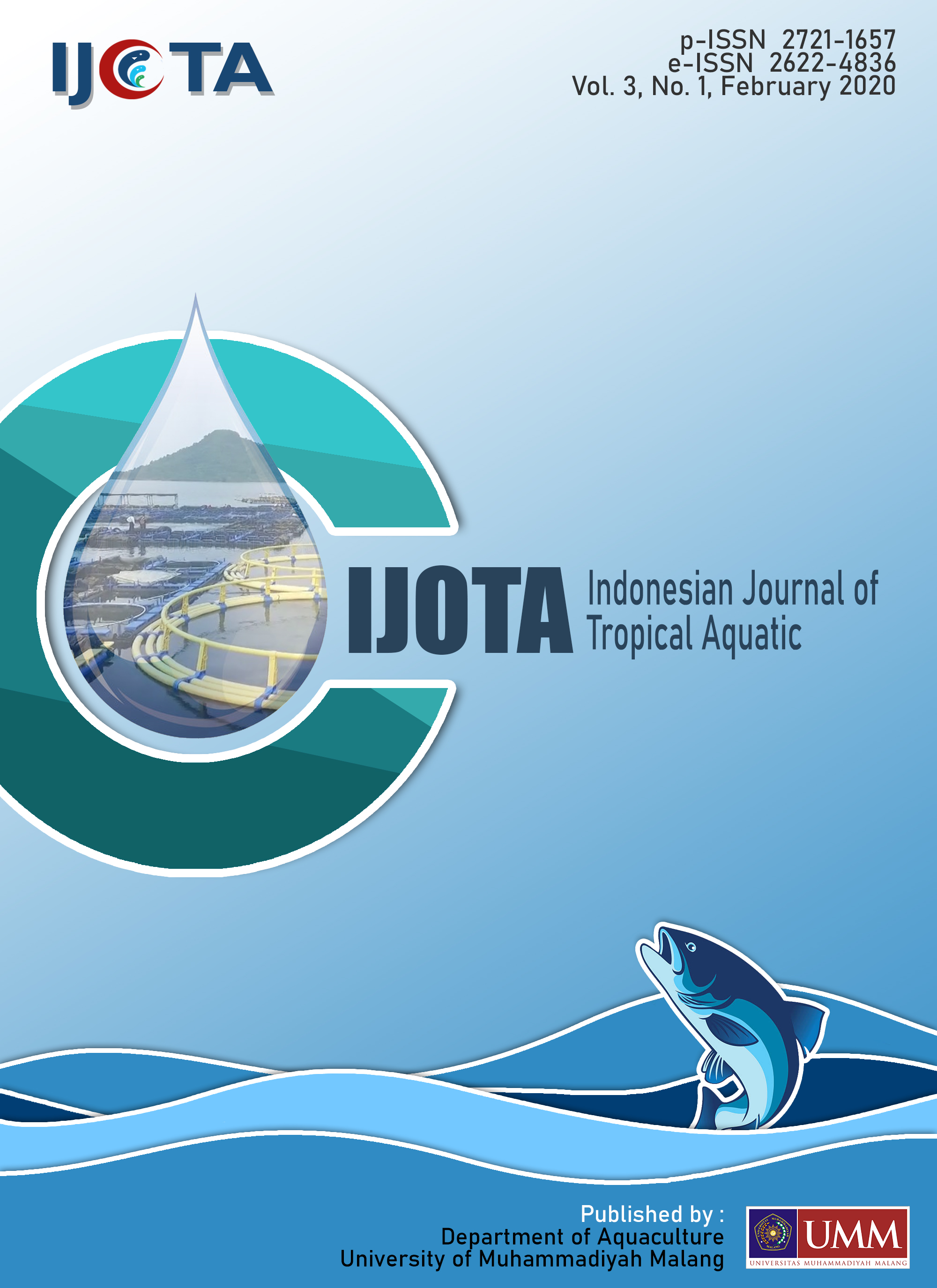Performance of Perkasa Pangasiid (Pangasianodon hypophthalmus) from family selection results
DOI:
https://doi.org/10.22219/ijota.v3i1.11217Keywords:
Growth Performance, Netcage Pond, Perkasa pangasiid, SelectionAbstract
Perkasa pangasiid (Pangasianodon hypophthalmus) is a superior catfish selected by the family that has been released by the Minister of Marine and Fisheries as aquaculture fish which has a selection response of 38.86 %. Genetic quality improvement to accelerate growth can be done through selection activities. The performance test of the Siamese catfish from the selection (Perkasa strain) compared to the non-selection strain (local strain) originating from the farmer. The purpose of this study was to compare the productivity of selection and non-selection Siamese catfish cultivation maintained in a net pond. The initial seeds of the test fish were 3.76 g to 3.79 g with a total length of 2 inches to 3 inches kept in a net pond measuring 3 × 5 × 1.25 m. The water level was around 100 cm with a density of 175 fish/net. Maintenance was carried out for six months. Test parameters observed included: weight gain, specific growth rate, biomass harvest, productivity and cost of production. The results showed that Siamese catfish which were selected for six months of maintenance had a final weight of 698.40 ± 164.54 g and non-selection strains of 595.77 ± 103.41 g. As well as having a higher specific growth rate (3.51 %), higher harvest biomass (11.44 %), and higher productivity (18.71 %) than non-selection Siamese catfish. Based on the bioeconomic analysis, the selection of enlarged Siamese catfish cultivation can reduce production costs up to Rp 390 /kg. The use of Perkasa Pangasiid superior seeds can increase harvest biomass higher than the non-selection seeds.Downloads
References
Dewi RRSPS, Tahapari E. 2017. Performa ikan lele afrika (Clarias gariepinus) hasil seleksi terhadap pertumbuhan, sintasan, konversi pakan, rasio rna/dna, dan nilai bioekonomi. Media Akuakultur, 12 (1): 11-17.
Dewi RRSPS, Iswanto B, Insan I. 2016. Produktivitas dan profitabilitas budidaya ikan lele (Clarias gariepinus) hasil seleksi dan non seleksi pada pemeliharaan di kolam tanah. Media Akuakultur, 11 (1): 11-17.
Gjedrem T. 2005. Selection and breeding programs in aquaculture. AKVAFORSk, Institute of Aquaculture Research As. Springer Dordrecht, Netherland. 364 pp.
Iswanto B, Suprapto R, Marnis H, Imron. 2015. Keragaan uji lapang pembesaran benih ikan lele (Clarias gariepinus) tumbuh cepat generasi ketiga. Prosiding Forum Inovasi Teknologi Akuakultur 2015: 95-102.
Khan MA, Huda FA. 2012. Comparative performance between genetically improved and traditional silver barb strain: a bioeconomic analysis. Progress. Agric. 23 (1): 133-142.
[KKP] Kementerian Kelautan dan Perikanan. 2016. Laporan Kinerja (LKJ) Direktorat Jendral Perikanan Budidaya tahun 2016. Jakarta (ID) : KKP
Nugroho E, Saepudin, dan Bajar, M. 2013. Kajian lapang penggunaan benih nila (O. niloticus) hasil pemuliaan di keramba jaring apung jatiluhur. Jurnal Riset Akuakultur, 8(1): 43-49.
Pamungkas W, Nurlaela I, Darmawan J. 2015. Analisis rasio RNA/DNA ikan patin siam Pangasianodon hypophthalmus F-2 tumbuh cepat hasil seleksi. Prosiding Forum Inovasi Teknologi Akuakultur 2015. 251-258.
Parenrengi A, Tonnek S, Tenriulo A. 2013. Analisis rasio RNA/DNA udang windu Penaeus monodon hasil seleksi tumbuh cepat. Jurnal Riset Akuakultur, 8 (1): 1-12.
Tahapari E, Darmawan J, Suharyanto. 2018. Genetic improvement of growth trait in Siamese catfish (Pangasianodon hypophthalmus Sauvage, 1878) through family selection. AACL Bioflux 11 (5): 1648-1657.
Downloads
Published
How to Cite
Issue
Section
License
Copyright (c) 2020 Indonesian Journal of Tropical Aquatic

This work is licensed under a Creative Commons Attribution-ShareAlike 4.0 International License.
IJOTA (Indonesian Journal of Tropical Aquatic) allows readers to read, download, copy, distribute, print, search, or link to its articles' full texts and allows readers to use them for any other lawful purpose. The journal allows the author(s) to hold the copyright without restrictions. Finally, the journal allows the author(s) to retain publishing rights without restrictions
- Authors are allowed to archive their submitted article in an open access repository
- Authors are allowed to archive the final published article in an open access repository with an acknowledgment of its initial publication in this journal


